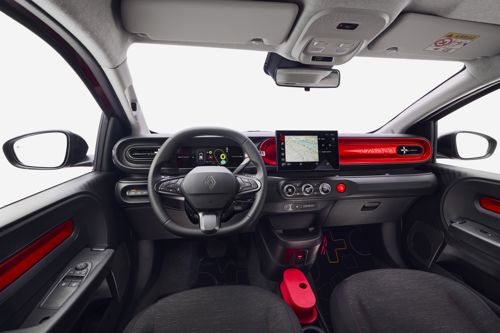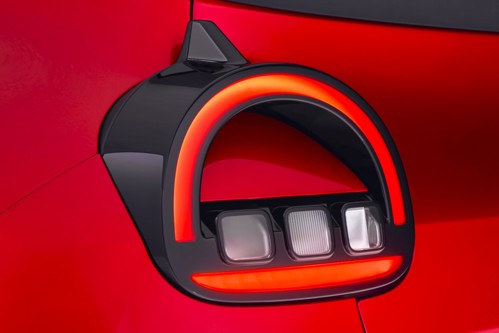Renault Twingo E-Tech Review 2025
Renault Twingo E-Tech At A Glance
For British car enthusiasts, any trip to a continental European destination has to include an ongoing game of Twingo Bingo. For the uninitiated, the rules are a score of two points whenever an original 1990s-vintage Renault Twingo is spotted, yet just one point each if a second- or third-generation model’s observed. But those rules are in imminent need of a re-write because it’s back. Now exclusively battery-powered, the Renault Twingo E-Tech is the French brand’s latest EV to pay homage to a much-loved original.
While the first-generation Renault Twingo was a roaring sales success across the Channel, it wasn’t officially sold in the UK. The model’s history here began with the sanitised-to-the-point-of-ordinariness Mk2 Twingo in 2007 and concluded with 2014’s much more interesting rear-engined third-generation Twingo, which disappeared from price lists five years later due to lacklustre sales.
After the critical acclaim of the reimagined Renault 5 E-Tech and its larger-despite-having-a-smaller-number SUV sibling, the Renault 4 E-Tech, the visual cues of the 1992 Twingo serve as the starting point for this new electric city car. Just look at its happy face!
Smaller than the R5, the Renault Twingo E-Tech is designed to excel in urban environments, hence why this adult-sized four-seater, five-door hatchback is just 3789mm long and can outmanoeuvre politicians with its 9.87-metre turning circle, perfect for manoeuvring between enormous SUVs.

As per the OG Twingo, the latest E-Tech has a sliding rear bench seat that also reclines allowing you to prioritise between passenger room and boot space. Renault quotes 360 litres for the luggage capacity, inclusive of a 50-litre well beneath the floor where charging cables can be stowed, expanding to over 1000 litres to ceiling level when the 50/50-split rear seatback’s folded over.
Withing the passenger compartment is further 19 litres of total storage capacity, including a centre console cubby and more than a dozen open trays and shelves, including one on the dash immediately ahead of the front passenger.
Although the Renault Twingo E-Tech’s dashboard has a playful style to it, including a white or body-coloured decor panel, charming graphics for the 7.0-inch driver’s display screen, the Reno on-board virtual assistant accessed via the 10.0-inch multimedia touchscreen and a Jean-Michel Jarre-penned welcome jingle. Only the oversized bright red hazard warning light button is reminiscent of the Mk1 version.

It looks up-to-date without being either dour or too much of a tech-fest and visually, at least, strikes an appealing balance for a car that’s set to cost from under £20,000. How much below that psychological benchmark remains to be seen, but that promise is bound to cause those selling the BYD Dolphin Surf and Hyundai Inster sleepless nights.
Not only that, it’s not significantly more than value-focused packages provided by the Leapmotor T03 and — from within Renault’s own family — the Dacia Spring.
Among the criticisms aimed at those two are that they are difficult to derive pleasure from driving — if the Twingo E-Tech has some of the magic sprinkled over the R4 and the R5, Renault could have another winner in its showrooms.
Certainly, the omens are promising as the new electric Twingo’s front suspension is identical to its slightly larger siblings while the rear end uses something similar to that found at the back of the Renault Captur — competent, then, if not the last word in sophistication.
So, all of this sounds very promising, doesn’t it, although you can sense a ‘but’ coming, can’t you? But what about the battery? Aah, yes, that’ll be it.
You see, Renault has been very focused on making the Twingo E-Tech right-sized for city life rather than a Jack-of-all-trades family car tasked with plying motorways, winding B-roads and urban streets several times per day. Not that the Twingo will be incapable of doing all of those things, but with a usable capacity of just 27.5kWh too much high-speed driving is going to sap-away the Renault’s already modest driving range claim.
While the exact figure is yet to be homologated to WLTP testing rules, Renault’s quoting a provisional range figure of 163 miles across the usual Combined cycle. Stick purely to town driving and — just maybe — 200 miles per charge could be possible, which for many urban commuters could be well over a week’s worth of journeys.
In standard guise the Renault Twingo E-Tech only includes a 6.6kW AC on-board charger, which is fine for plugging in at home using a domestic wallbox. Using this kind of set-up means a 10-100% recharge should take around 4 hours 15 minutes — remember, a small battery has the advantage of requiring less time to charge, even on a relatively slow connection.

Opting for the 11kW AC on-board charger includes a 50kW DC version to make matters easier when taking your Twingo further afield. That’s still a low energy flow for a CCS-connection public charging point, but it enables the Renault’s battery to increase from a 10-80% state of charge in 30 minutes.
Performance is set to be adequate for a city car as the Twingo E-Tech’s powered by an 82PS electric motor that produces 75Nm of torque, enabling it to whirr from 0-62mph in 12.1 seconds. Top speed is an electronically capped 81mph maximum.
As is the EV norm, the Renault Twingo E-Tech has a single-speed transmission which is operated in the manner of a conventional automatic gearbox, making city driving smoother, less stress and with lower levels of physical fatigue.
Two levels of specification will be offered for the Renault Twingo E-Tech range, following the firm’s established naming conventions of Evolution and Techno. Standard features for the entry-level Evolution are set to include 16-inch steel wheels with trims, air-conditioning — with physical controls rather than touchscreen-based ones — Android Auto and Apple CarPlay smartphone connectivity, the sliding rear seat bench, cruise control and an advanced driver monitoring system.
Upgrading to the Twingo E-Tech Techno is likely to add automatic main beam headlights and windscreen wipers, dark-tinted rear windows, electrically folding door mirrors, keyless entry and exit, a reversing camera, an upgraded Google-based multimedia system, automatic climate control and adaptive cruise control that maintains a set gap to the vehicle in front.
Depending on the version you choose, up to 24 driver assistance systems are fitted to the Twingo E-Tech, including 12 all-round bodywork sensors to guide the Renault’s self-parking technology.
Renault also claims that the electric Twingo Techno will benefit from its One Pedal driving system in which maximum levels of regenerative braking are available simply by lifting off the throttle without the need to trouble the device immediate to its left.
UK customers hoping to get their hands on the Renault Twingo E-Tech are going to have to wait until 2027 before getting their hands on one, although at this stage it’s unclear if order books will open towards the end of 2026, allowing buyers to specify their car to their tastes.
Keep this page bookmarked for further news on this important new model and to read our comprehensive electric Renault Twingo E-Tech review in the months ahead.









 Adorably cutesy styling gives kerb appeal. City-centric dimensions, including the battery capacity. Set to cost sub-£20k.
Adorably cutesy styling gives kerb appeal. City-centric dimensions, including the battery capacity. Set to cost sub-£20k.
 Tiny battery, slow charging and 163-mile range may curb its appeal. Sales don’t begin until 2027. Desirable Techno version likely to be over £20k.
Tiny battery, slow charging and 163-mile range may curb its appeal. Sales don’t begin until 2027. Desirable Techno version likely to be over £20k.




